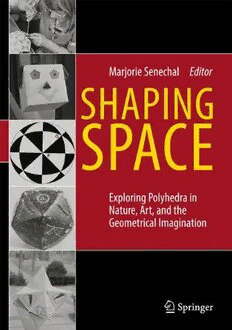
Shaping Space: Exploring Polyhedra in Nature, Art, and the Geometrical Imagination PDF
Preview Shaping Space: Exploring Polyhedra in Nature, Art, and the Geometrical Imagination
Shaping Space Exploring Polyhedra in Nature, Art, and the Geometrical Imagination http://avaxho.me/blogs/ChrisRedfield Marjorie Senechal Editor Shaping Space Exploring Polyhedra in Nature, Art, and the Geometrical Imagination with George Fleck and Stan Sherer 123 Editor MarjorieSenechal DepartmentofMathematicsandStatistics SmithCollege Northampton,MA,USA ISBN978-0-387-92713-8 ISBN978-0-387-92714-5(eBook) DOI10.1007/978-0-387-92714-5 SpringerNewYorkHeidelbergDordrechtLondon LibraryofCongressControlNumber:2013932331 MathematicsSubjectClassification:51-01,51-02,51A25,51M20,00A06,00A69,01-01 ©MarjorieSenechal2013 Thisworkissubjecttocopyright.AllrightsarereservedbythePublisher,whetherthewholeorpartofthematerialisconcerned, specificallytherightsoftranslation,reprinting,reuseofillustrations,recitation,broadcasting,reproductiononmicrofilmsorin anyotherphysicalway,andtransmissionorinformationstorageandretrieval,electronicadaptation,computersoftware,orby similarordissimilarmethodologynowknownorhereafterdeveloped.Exemptedfromthislegalreservationarebriefexcerptsin connectionwithreviewsorscholarlyanalysisormaterialsuppliedspecificallyforthepurposeofbeingenteredandexecutedon acomputersystem,forexclusiveusebythepurchaserofthework.Duplicationofthispublicationorpartsthereofispermitted onlyundertheprovisionsoftheCopyrightLawofthePublisherslocation,initscurrentversion,andpermissionforusemust alwaysbeobtainedfromSpringer.PermissionsforusemaybeobtainedthroughRightsLinkattheCopyrightClearanceCenter. ViolationsareliabletoprosecutionundertherespectiveCopyrightLaw. Theuseofgeneral descriptive names,registered names,trademarks, service marks,etc.inthis publication doesnotimply, evenintheabsenceofaspecificstatement,thatsuchnamesareexemptfromtherelevantprotectivelawsandregulationsand thereforefreeforgeneraluse.Whiletheadviceandinformationinthisbookarebelievedtobetrueandaccurateatthedateof publication,neithertheauthorsnortheeditorsnorthepublishercanacceptanylegalresponsibilityforanyerrorsoromissions thatmaybemade.Thepublishermakesnowarranty,expressorimplied,withrespecttothematerialcontainedherein. Printedonacid-freepaper SpringerispartofSpringerScience+BusinessMedia(www.springer.com) Contents PartI FirstSteps 1 IntroductiontothePolyhedronKingdom ....................................... 3 MarjorieSenechal 2 SixRecipesforMakingPolyhedra ............................................. 13 MarionWalter,JeanPedersen,MagnusWenninger,DorisSchattschneider, ArthurL.Loeb,ErikDemaine,MartinDemaine,andViHart 3 RegularandSemiregularPolyhedra............................................ 41 H.S.M.Coxeter 4 MilestonesintheHistoryofPolyhedra.......................................... 53 JosephMalkevitch 5 Polyhedra:SurfacesorSolids? ................................................ 65 ArthurL.Loeb 6 Du¨rer’sProblem ............................................................. 77 JosephO’Rourke PartII PolyhedrainNatureandArt 7 ExploringthePolyhedronKingdom ............................................ 89 MarjorieSenechal 8 SpatialPerceptionandCreativity .............................................. 109 JanosBaracs 9 GoldbergPolyhedra.......................................................... 125 GeorgeHart 10 PolyhedraandCrystalStructures.............................................. 139 ChungChieh 11 PolyhedralMolecularGeometries.............................................. 153 MagdolnaHargittaiandIstvanHargittai 12 Form,Function,andFunctioning .............................................. 171 GeorgeFleck v vi Contents PartIII PolyhedraintheGeometricalImagination 13 ThePolyhedronKingdomTomorrow........................................... 193 MarjorieSenechal 14 PaneledandMolecularPolyhedra:HowStableAreThey?........................ 201 IleanaStreinu 15 DualityofPolyhedra ......................................................... 211 BrankoGru¨nbaumandG.C.Shephard 16 CombinatorialPrototiles...................................................... 217 EgonSchulte 17 PolyhedraAnaloguesofthePlatonicSolids...................................... 223 Jo¨rgM.Wills 18 ConvexPolyhedra,DirichletTessellations,andSpiderWebs ...................... 231 WalterWhiteley,PeterF.Ash,EthanBolker,andHenryCrapo 19 UniformPolyhedrafromDiophantineEquations ................................ 253 BarryMonson 20 TorusDecompostionsofRegularPolytopesin4-space ............................ 257 ThomasF.Banchoff 21 TensegritiesandGlobalRigidity ............................................... 267 RobertConnelly 22 TenProblemsinGeometry .................................................... 279 MoritzW.SchmittandGu¨nterM.Ziegler 1. UnfoldingPolytopes...................................................... 279 2. AlmostDisjointTriangles ................................................. 280 3. RepresentingPolytopeswithSmallCoordinates............................... 281 4. PolyhedrathatTileSpace.................................................. 282 5. Fatness ................................................................. 283 6. TheHirschConjecture .................................................... 284 7. Unimodality............................................................. 285 8. DecompositionsoftheCube ............................................... 286 9. TheBall-and-CubeProblem................................................ 287 10. The3d Conjecture........................................................ 288 NotesandReferences ............................................................. 291 SourcesandAcknowledgments .................................................... 321 Index ........................................................................... 327 Preface Molecules,galaxies,artgalleries,sculpture,viruses,crystals,architecture,andmore:ShapingSpace: exploring polyhedra in nature, art, and the geometrical imagination is an exuberant survey of polyhedrain nature and art. It is at the same time hands-on,mind-turned-onintroductionto one of the oldest and mostfascinatingbranchesof mathematics.In these pagesyouwill meet some of the world’sleadinggeometers,andlearnwhattheydoandwhytheydoit.Inshort,ShapingSpaceisas many-facetedaspolyhedrathemselves. Shaping Space is a treasury of ideas, history, and culture. For students and teachers, from elementary school to graduate school, it is a text with context. For the multitude of polyhedra hobbyists,anindispensablehandbook.ShapingSpaceisaresourceforprofessionals—architectsand designers,paintersandsculptors,biologistsandchemists,crystallographersandphysicistsandearth scientists,engineersandmodelbuilders,mathematiciansandcomputerscientists.Ifyouareintrigued bytheexquisiteshapesofcrystalsandwanttoknowhownaturebuildsthem,ifyoumarvelatdomes and wonderwhy most stay up but some fall down, if you wonder why Plato thoughtearth, air, fire andwaterweremadeofpolyhedralparticles,if youwonderwhatgeometryisandarewillingtotry ityourself,thisbookisforyou.InShapingSpaceyouwillseethatpolyhedraareasnewastheyare old, and that they continueto shape our spaces in new and exciting ways, from computergamesto medicalimaging. Thecomputerrevolutionhascatalyzednewresearchonpolyhedra.Aquartercenturyago,discrete and computational geometry (the branch of mathematics to which polyhedra belong) was less a field in its own right than—in the eyes of many people, even many mathematicians—a grab-box of mathematical games. Today an international journal, Discrete and Computational Geometry, publishes six issues a year with the latest research on configurations and arrangements, spatial subdivision,packing,covering,andtiling,geometriccomplexity,polytopes,pointlocation,geometric probability, geometric range searching, combinatorial and computational topology, probabilistic techniquesincomputationalgeometry,geometricgraphs,geometryofnumbers,andmotionplanning, andpaperswithadistinctgeometricflavorinsuchareasasgraphtheory,mathematicalprogramming, real algebraic geometry, matroids, solid modeling, computer graphics, combinatorial optimization, imageprocessing,patternrecognition,crystallography,VLSIdesign,androbotics. vii viii Preface Figure1. Anicosahedronbuiltanddecoratedbyelementaryschoolchildren.PhotographbyStanSherer. Figure2. SculpturesbyMortonBradley.PhotographbyStanSherer. Yet,itisalsotrue,asthesayinggoes,plusc¸achange,plusc’estlameˆmechose.Themorethings change,the moretheystay thesame, especiallyin schoolmathematicscurricula.Despite itscentral importance in the sciences, the arts, in mathematics and in engineering, solid geometry has all but vanishedfromthe schools, planegeometryis beingsqueezedto a minimum,and model-buildingis relegatedto kindergarten.Reasonsforthisunfortunate(and,unfortunately,long-term)trendinclude a lack of teacher training and pressures to teach testable skills. But educators will realize, sooner rather than later, that “technology in the classroom” is more than clicking the latest gadgets, it Preface ix meansunderstandingourtechnologicalworld.Geometrywillreappearasablendofmodel-building, engineeringandfundamentalmathandscience. Meanwhile, the internet is helping to bring geometry back to life and with it a community of geometers. You can explore polyhedrain nature, art, and the geometricalimaginationon the world widewebbyyourself,withShapingSpaceasyourguide,andshareyourfindingsandfrustrationswith thelike-mindedthroughchatgroups.Keeppencils,paper,aruler,scissors,andtapehandy:Confucius gotitright2500yearsago: IhearandIforget, IreadandIremember, IdoandIunderstand. ShapingSpacewillevolveasthesubjectgrows.Thenotesandreferencesattheendofthisbookare alsoonmywebsite,http://www.marjoriesenechal.com.Authorswillpostupdatesthere;youwillalso findlinkstoinstructionalandrecreationalmaterials,andtowebsitesofpolyhedra-mindedscientists, artistsandhobbyists.Visitoften! Indeed, Shaping Space has grown already. Its ancestor, Shaping Space: a polyhedral approach was inspired by a three-day festival of workshops, exhibitions and lectures on polyhedra held at Smith College in 1984. Shaping Space: Exploring Polyhedra in Nature, Art, and the Geometrical ImaginationincludesthebestofthepastandnewchaptersbyRobertConnelly,ErikDemaine(with Martin Demaine and Vi Hart), George Hart, Joseph O’Rourke, Ileana Streinu, and Gu¨nter Ziegler (withMoritzSchmidt). Figure3. H.S.M.Coxeter(1907–2003).PhotographbyStanSherer.
